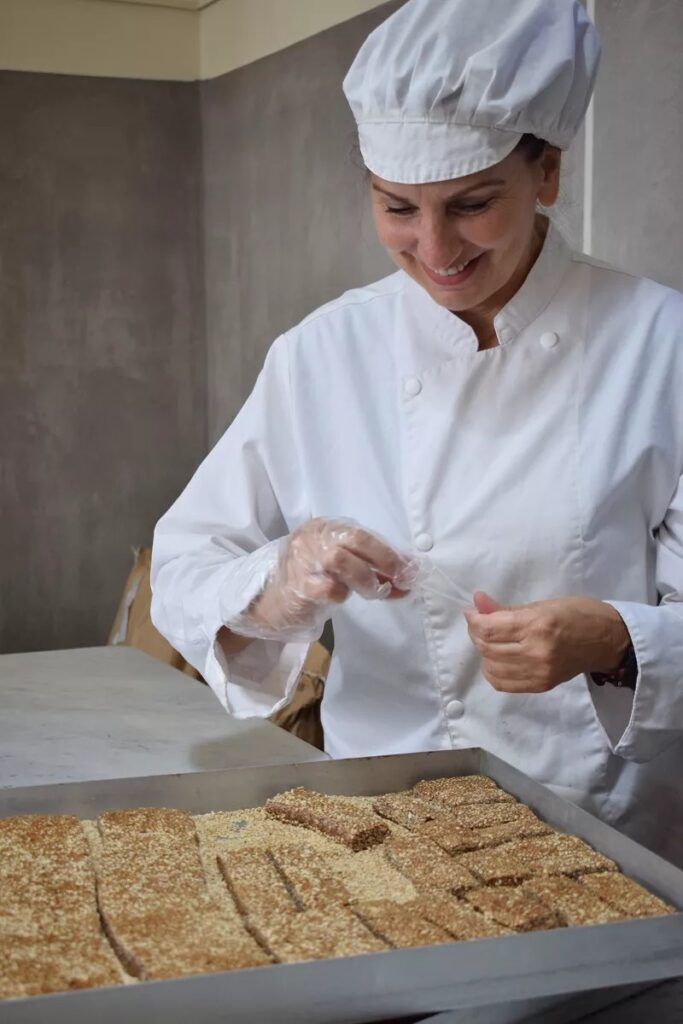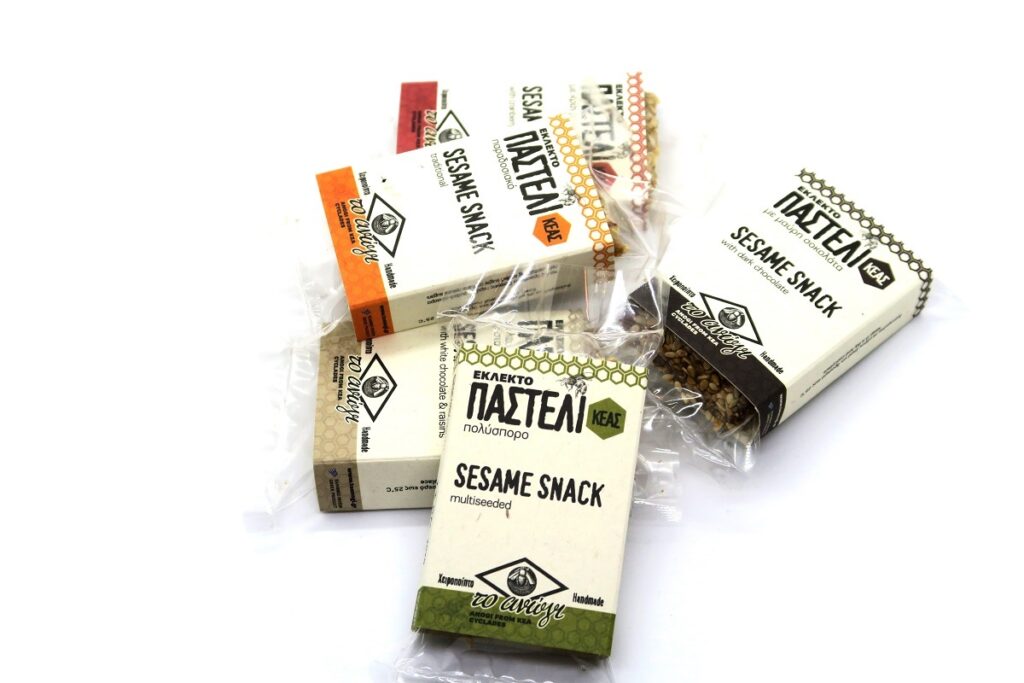Experienced, persistent and skilful hands have been mixing, for years now, the confectionery history of an entire island with the inspiration and dedication of a family tradition to the pure, unique and authentically delicious Kea pasteli.
The people of Kea speak today with sweetness and pride about "To Anogi" pasteli. Their own Anogi made the island's traditional pasteli known in the Cyclades, Athens, and even France.
When Mr. Nikos Maroulis, a professional confectioner, sought out the old pastry chef K. Kyknas in his hometown of Kea in the 1960s to help him learn the art of pasteli, perhaps they did not imagine in the slightest that his productions would continue to be consistent over the decades.
"My father-in-law", Garifallia, a successor of the business, explains to me, "was a pioneer in the spread of pasteli on the island, and in fact, by following the recipes he was taught, he was able to perfect them, and from 1970, he started his own confectionery workshop supplying all of Kea with his pasteli."
As I am informed, while pastelia was the pre-eminent treat at funerals and memorial services according to the traditions of the island, Mr Nikos, by sealing them, first of all, in a box and channelling them to the local market, making them widely known to visitors to the island, while he also tempted the locals of Kea to start seeing them differently themselves.
Soon, his pasteli would enter homes as well, as an exquisite sweet treat that can not only bring sorrow but also joy. In fact, Kea locals and non-locals alike are now asking the Maroulis family to make sweets for them, including weddings and christenings.

Today and as early as 2007, Anogi has left Kea, moving to Athens, and in fact, to an area where many Kea islanders live, in Agios Dimitrios. There, in the privately owned family workshop, the flavours, habits and tactics that once sweetly tied this story together and that continue to do so, as in the past, with good honey, plenty of almonds from the island and fragrant orange peel, have been seamlessly transferred.
"All the processes," Garifalia tells me, "are still done by hand, just like before. We don't even have a machine to mix. When I ask my husband to get an electric mixer, he refuses, explaining that it will change the taste of our pasteli's. And he's right!"
As for the secrets of a good pasteli, these are "hidden in the good raw materials", Garifalia assures me, "as well as in how we manage them, from the good washing of the sesame to the correct roasting of the nuts. It is also important," she adds, "that the soft pasteli, like ours, does not stick to the teeth and is easy to chew. But above all", she summarises, "what makes the difference, and not only in pasteli, is that everything is done with love, passion and patience, just like in the old days when the quality of production was not affected from the anxiety of quantity."
The pure raw materials that embody tradition and locality

Asking to know more about the raw materials and where they get them from, Garifalia makes it clear to me that the almonds - as they are abundant on the island - come entirely from the lands of Kea. The same also applies to honey when they find good and sufficient quantities from local beekeepers.
For all the other ingredients, the family has mapped its own local network of small producers throughout Greece, with whom it collaborates to bring, for example, from Volos the best nut butter (it has also been making bars for the last few years), from Xanthi sesame and tahini and dried bananas from Crete.
In the e-shop of the workshop as well as in selected shops in Athens (deli, grocery stores, dry fruit shops and some organic shops) and in all the supermarkets and tourist shops of Kea (as well as on the boats that connect the island with Athens and with Kythnos) one can look for five different suggestions in pastelis and more than 15 in cereal, oat and protein bars.
"The most popular bars," Garifalia tells me, "are the ones that contain nut butter and dark chocolate, while our number one selling bar is the one with hazelnut butter, oats, honey, coarsely chopped and roasted hazelnuts, and of course, dark chocolate."
However, there are also three proposals for organic bars: one with cashew butter and banana; another with whole grain tahini, figs, walnuts, raisins and cocoa; and the third with peanut butter and nuts.

As for pastelis, the traditional Keas pasteli with almond and orange zest is consistently at the top of preferences (Kea locals eat pasteli with sugar and glucose, while Athenians eat it with honey).
The list, however, is completed by four more pastelis: the multi-seeded pasteli with flaxseed, poppy seed, pumpkin seed, sunflower seed and orange peel; the pasteli with cranberry, cashew and Indian coconut; the pasteli with dark chocolate, orange and almond and finally, the pasteli with white chocolate, raisins and lemon zest.
e-shop: toanogi.gr
Loukia Chrysovitsanou is a columnist for Olive Magazine.

